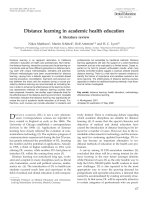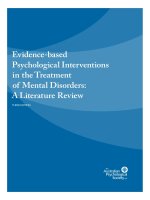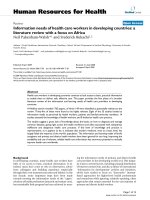Economic burden of cardiovascular disease A literature review
Bạn đang xem bản rút gọn của tài liệu. Xem và tải ngay bản đầy đủ của tài liệu tại đây (442.65 KB, 86 trang )
ACKNOWLEDGEMENTS
First of all, I would like to express my deepest gratefulness to my supervisor,
MSc. Doan Ngoc Thuy Tien, for supporting and guiding me with careful, patience
during this thesis.
I am also grateful to all lecturers and staffs in the Institute of Preventive Medicine
and Public Health and Hanoi Medical University for their suppons throughout the
academic year.
Finally, I must express my verx profound gratitude to my family and to my friends
for providing me with unfailing support and continuous encouragement throughout my
years of study. This accomplishment would not have been possible without them.
r-u -ÍM Qỉ ugc V Hl
COMMITMENTS
I declare that the thesis The economic burden of cardiovascular disease: A
literature review" is my own work under the guidance of MSc. Doan Ngoc Thuv l ien
The Institute of Preventive Medicine and Public Health, Hanoi Medical University,
Hanoi. Vietnam, and that I acknowledged all results and quotations from the published
or unpublished work of other people.
All data and results in this thesis were honest This thesis was compliant with
ethical standards in research
Hanoi. 14u'May 6,2021
Author of thesis
Vu Phuong Van
r-u -ÍM CỊỈ ugc V Hl
TABLE OF CONTENT
ACKNOWLEDGEMENTS
COMMITMENTS
ABBREVIATIONS
ABSTRACT
INTRODUCTION
CHAPTER LLITERATURE REVIEW......................................................3
1.1. Literature review..................................................................................................3
1
1.2. Cardiovascular diseases.....................................................................................3
1.3. Epidemiology of CVD...........................................................................................9
1.4. Burden of cardiovascular..................................................................................10
1.5. Cost of illness.....................................................................................................11
1.5.1. Types of cost of illness..............................................................................12
1.5.2. Approaches of cost
of illness studies...................................................14
1.5.3. Perspectives of cost
of illness studies...................................................16
1.6. Cost of illness by cardiovascular disease........................................................17
1.6.1. Direct cost...................................................................................................17
16 2.
Indirect cost................................................................................................18
I7
Factors associated with cost of il Iness of cardiovascular disease.................19
CHAPTER 2. SUBJECTS AND RESEARCH METHOD..........................21
2.1. Study design......................................................................................................21
2.2. Eligible criteria....................................................................................................21
2.2.1. Inclusion criteria.........................................................................................21
2.2.2. Exclusion criteria........................................................................................21
2.3. Search methods for identification of studies.....................................................22
2.4. Selection of studies............................................................................................23
r-u -ÍM Qỉ ugc V Hl
2.5.
Data extraction and management......................................................................23
2.6.
Data synthesis....................................................................................................25
CHAPTER 3. RESULTS................................................................................27
3.1.
Results of the search.........................................................................................27
3.2.
Study characteristics..........................................................................................28
3.3.
Cost of illness anillysis.......................................................................................45
3.3.1.
Direct cost...................................................................................................45
3.3.2.
Indirect cost.................................................................................................48
3.4 Associated factor to the cost of ill ness caused by cardiovascular disease 50
CHAPTER 4. DISCISSION...........................................................................55
4 I Summarizing the cost of illness associated with cardiovascular disease . 55
4.2 Reviewing some factors related to the cost of illness caused by cardiovascular
disease..........................................................................................................................58
CONCLUSION...............................................................................................63
RECOMMENDATIONS................................................................................64
REFERENCES
r-u -ÍM CỊỈ ugc V Hl
LIST OF TABLES
Table l.l.
Table 1.2.
Table 1.3.
Table 2.1.
Table 3.1.
Table 3.2.
Table 3.3.
Table 3.4.
Table 3.5.
Table 3.6.
T11C number of deaths ca used by CVD in 2015..................................9
Examples of direct and indirect costs...................................................14
Examples of costs included in cost of illness studies by
perspectives.......................................................................................17
Search terms.........................................................................................22
List of included studies..........................................................................30
Cost types & descriptions......................................................................36
Types of CVDs......................................................................................43
Standardized direct cost of cardiovascular disease data.....................45
Standardized indirect cost of cardiovascular disease data..................48
Associated factor to the cost of illness caused by cardiovascular
disease...............................................................................................50
LIST OF FIGLRF.S
Figure 1.1. Roles of cost of illness studies..................................................................12
Figure 2.1.
PRISMA diagram of searching and screening process.....................25
Figure 3 .1.
PRISMA diagram of searching and screening process.....................27
Figure 3.2.
Proportion of studies divided by geographical region........................28
Figure 3.3.
Proportion of studies divided bv tile countries.....................................29
r-u -ÍM Qỉ ugc V Hl
ABBREVIATIONS
Coronary artery disease
CAD
CVD
CUD
DVT
GBD
GDP
HDL
Cardiovascular disease
Coronary heart disease
Deep vein thrombosis
Global burden of disease
Gross domestic product
High - density lipoprotein
Higher - income countries
HICs Health transformation plan
HTP Iranian rials
1RR Low - density lipoprotein
LDL Low - and middle - income countries
LMICsMyocardial infarction
MI
Out-of-pocket
OOP Peripheral arterial disease
PAD Preferred reporting items for systematic reviews and metaanalyses
Purchasing power parity
PRISMA
United states dollar
PPP World health organization
USD
WHO
ABSTRACT
Background: Cardiovascular diseases are a major contributor to reduced quality
of life, which caused economic consequences at multiple levels: individuals,
households, economic agents, public institutions, government, and the society as a
whole. Especially in the low-and middle-income Asian countries, cardiovascular
diseases began to spread out leading to an increasing number of prevalence and
escalating healthcare spending Sufficient understanding of cost of illness is crucial in
the formulation of healthcare policies as well as the rational allocation of healthcare
resources in accordance with budget constraints
Objectives: This literature review aims to summarize the cost of illness studies
associated with cardiovascular diseases and review some factors related to the cost of
illness caused by cardiovascular diseases,
Methods: A literature search was perfonned on Google Scholar and PubMed.
Cost was summarized in terms of direct cost, indirect cost and each was converted to
USD in 2020 for further comparison. Cost components (including direct and indirect
costs) were scrutinized to identify the key cost drivers and factors associated with
these costs
Results: A total of 19 studies were included in this review. Most studies assessed
costs from the patient perspective (n = 16), with the remainders being from the societal
perspective, health service provider perspective. Most studies were collected during
the period from 2007 to 2021. chiefly included data from India (n - 7) Costs are mainly
paid by the individual and family’s patients (Out-of-pocket payment). Indirect costs
incurred by productivity losses due to morbidity and premature mortality. The cost of
cardiovascular diseases was found to be correlated with some risk factors, the nature
of health facility, income quintiles and sonic other factors.
r-u -ÍM CỊỈ Hgc V Hl
Conclusion: Direct costs for CVDs in each and evety countty are distinct Indirect
cost tends to lie less calculated 111 research OOP in LMICs could result in financial
catastrophe and increasing the economic burden for them Factors that influence on
the costs of illness, includes some risk factors, residence location, income quintiles,
the nature of health facility*, socio-economic status of patients, health transformation
plan, comorbidity, discharge status
Keywords: economic burden, costs of illness, cardiovascular diseases. Asia,
literature review.
r-u -ÍM CỊỈ ugc V Hl
1
INTRODUCTION
Cardiovascular diseases (CVDsX consisting of ischemic heart disease, stroke,
heart failure, peripheral arterial disease, and a number of other cardiac and vascular
conditions, constitute the leading cause of global mortality and are a major contributor to
12
reduced quality of life
In 2017. It was estimated 17.8 million deaths worldwide,
corresponding to 330 million years of life lost and another 35.6 million years lived with
disability due to CVDs
2
In Vietnam, CVDs caused about 31% of total deaths in 2016.
corresponding to more than 170 000. ’
In addition to the large health burden, disability caused by CVDs has economic
consequences at multiple levels: individual, household, economic agents, public
institutions, government, and the society as a whole. Whist the premature deaths from
CVDs and other NCDs are considered as the consequences of reducing productivity,
curtails economic growth. and pose a significant social challenge in most countries This
comes in the form of direct healthcare costs related to the prevention and treatment of
CVDs and their risk factors. Furthermore, there are several indirect costs related to
CVDs. These include the lost productivity of workers struck. Other costs refer to the lost
savings and assets that are foregone when families must face with catastrophic
healthcare expenditures such as stroke rehabilitation or dialysis, when available.
Globally, It is estimated that from 2011 to 2025 the economic burden of NCDs will be
USD 7 trillion, with CVDs accounting for most of that expense. 5*riiC American Heart
Association has published recently an analysis report suggesting that that total direct
(medical) and indirect (lost productivity) costs of CVDs. the most costly of all chronic
diseases, are supposed to rise from $555 billion III 2015 to $1.1 trillion in 2035.'
Although age-standardized mortality from CVDs has decreased in man) regions of
the world, the absolute number of deaths continues to increase, with the majority now
occurring in the low and middle income countries (LMICs). 4 The global number of deaths
r-u -ÍM CỊỈ ugc V Hl
2
from CVDs has grown by 12.5% during the past decade. Population growth and aging
populations have supported these changes, with the largest number taking place in
South and East Asia countries because of their enormous and growing populations. It IS
evident that multiple factors arc causally related to CVDs. including traditional individuallevel risk factors (mainly tobacco use. lipids, and elevated blood pressure) and societal
level health determinants (eg., health systems, health policies, and barriers to CVDs
prevention and care). These are more and more soaring in the low- and middle-income
countries leading to an increasing number of prevalence and healthcare cost.s
Understanding trends 111 the escalating costs of CVD IS important to develop informed
healthcare policy, effective interventions as well as efficient allocation of healthcare
resources in accordance with budget constraints that ultimately reduces the economic
impact of CVD on health care system and society; 111 turn, encourages residents to
have a healthier lifestyle and secure their economic status To our understanding, there
were very few literature studies of costs of CVDs carrying out in Asian countries despite
of Its onerous burden.
Therefore, a comprehensive analysis of the cost of illness in alleviating the
economic burden of CVDs in Asian countries was conducted with two follow ing
objectives:
1. Summarizing the cost of illness associated with cardiovascular disease.
2. Reviewing some factors related to the cost of illness caused by cardiovascular
disease.
r-u -ÍM CỊỈ ugc V Hl
3
CHAPTER I.LITERATURE REVIEW
1.1. Literature review
Literature review is cliaractcrized by a thorough examination, all- inclusive study, a
detailed analysis of the literary works that arc significant research topic and research
questions, identifying issues and research through research answers, the discover)' and
validation of new ideas and systematic approach of considering elements of ideas as a
fraction of any additional work.9
1.2. Cardiovascular diseases
Cardiovascular diseases IS not a single disease, but a cluster of diseases and
injuries that affect the cardiovascular system of human body (the heart and blood
vessels) Cardiovascular diseases refer to coronary heart disease; angina; stroke;
rheumatic heart disease, congenital heart disease; peripheral arterial disease; aortic
aneurysm
and dissection; deep vein thrombosis; and other (less common)
cardiovascular di seases '
Coronary licart disease (CHD), also called coronary artery disease (CAD) and
atherosclerotic heart disease. IS the end result of the accumulation of atheromatous
plaques within the walls of the arteries that supply the myocardium (the muscle of the
heart) (Abnormal inflammatory accumulations of macrophage white blood cells). Plaque
is made up of deposits of cholesterol and other substances in the artery'. Plaque buildup
causes the inside of the arteries to narrow over time, which can partially or totally block
the blood flow, for some people, the first sign of CAD IS a heart attack with symptoms.
Chest pain or discomfort, upper back or neck pain, indigestion, heartburn, nausea or
vomiting, extreme fatigue, upper body discomfort, dizziness, and shortness of breath.
Over lime, CAD can weaken the heart nwscle. This may lead to heart failure, a serious
condition where the heart can't pump blood the way it should
1
Ute pain associated with
very advanced CHD is known as angina that is essentially a cramp in the heart muscle i:
-ÍM CỊỈ ugc V Hl
4
A stroke, sometimes called a brain attack, occurs when something blocks blood
supply to part of the brain or when a blood vessel in the brain bursts. In either case,
parts of the brain become damaged or die. A stroke -can cause lasting brain damage,
long - term disability, or even death There are two types of stroke:
r-u -ÍM CỊỈ ugc V Hl
5
Cardiovascular disease lias (lie highest mortality late of non- communicable
diseases. But this is a disease that can prevent and reduce the severity of the disease
through the prevention and good control of risk factors. including:21-22
- High blood pressure: High blood pressure is a major risk factor for heart disease
It is a medical condition that happens when the pressure of the blood in your arteries
and other blood vessels is too high. The high pressure, if not controlled, can affect your
heart and other major organs of your body, including your kidneys and brain High blood
pressure IS often called a “silent killer" because it usually has no symptoms.
- Unhealthy blood cholesterol levels Cholesterol is a waxy, fat-like substance
made by the liver or found in certain foods. Your liver makes enough for your body's
needs, but we often get more cholesterol from the foods we cat. If wc take 111 more
cholesterol than the body can use, the extra cholesterol can build up in the walls of the
arteries, including those of the heart. This leads to narrowing of the arteries and can
decrease the blood flow to the heart, brain, kidneys, and other parts of the body There
arc two main ty pes of blood cholesterol LDL (low-density lipoprotein) cholesterol, which
IS considered to be "bad” cholesterol because it can cause plaque buildup in your
arteries, and HDL (high-density lipoprotein) cliolcstcrol. which is considered to be "good"
cholesterol because higher levels provide some protection against heart disease. High
blood cholesterol usually has no signs or symptoms.
- Diabetes mcllitus: Insulin IS a hormone made 111 the pancreas that helps move
glucose from the food you eat to your body's cells for energy If you have diabetes, your
body doesn't make enough insulin, can’t use its own insulin as well as it should, or both.
Diabetes causes sugar to build up in the blood The risk of death front heart disease for
adults with diabetes IS higher than for adults who do not have diabetes.
- Overweight and obesity: Obesity is excess body fat Obesity IS linked to higher
‘bad" cholesterol and triglyceride levels and to lower "good” cholesterol levels. Obesity
can lead to high blood pressure and diabetes as well as heart disease.
r-u -ÍM Qỉ ugc V Hl
6
- Unhealthy diet. Eating a diet high in saturated fats, trans fat, and cholesterol has
been linked to heart disease and related conditions, such as atherosclerosis. Also, too
much salt (sodium) in the diet can raise blood pressure,
- Physical inactivity: Not getting enough physical activity can lead to heart
disease. It can also increase the chances of having other medical conditions that are risk
factors, including obesity', high blood pressure, high cholesterol, and diabetes.
- Excessive alcohol use: Drinking too much alcohol can raise blood pressure
levels and the risk for heart disease. It also increases levels of triglycerides, a fatty
substance 111 the blood which can increase liter risk for heart disease. Women should
have no more than I drink a day. Men should have no more than 2 drinks a day.
- Tobacco use: increases tile risk for heart disease and licart attack: Cigarette
smoking can damage the heart and blood vessels, which increases your risk for heart
conditions such as atherosclerosis and heart attack. Nicotine raises blood pressure
Carbon monoxide from cigarette smoke reduces the amount of oxygen that your blood
can carry Exposure to secondhand smoke can also increase the risk for heart disease,
even for nonsmokers.
r-u -ÍM CỊỈ ugc V Hl
7
1.3.
F.pidemiologv of CVD
Prevalent cases of total CVD nearly doubled from 271 million (95% uncertainty
interval (LI): 257 to 285 million) in 1990 to 523 million (95% LI 497 to 550 million) in
2019, and the number of CVD deaths steadily increased from 12.1 million (95% UI:11.4
to 12 6 million) in 1990. reaching 18.6 million (95% LI: 17 I to 19.7 million) in 2O19.' J
In 2015, there were an estimated 422.7 million cases of CVD (95% uncertainty
interval: 415.53 to 427 87 million cases) and 17.92 million CVD deaths (95% uncertainty
interval: 17.59 to 18.28 million CVĐ deaths). Declines in the age-standardized CVD
death rate occurred between 1990 and 2015 111 all high-income and some middleincome countries. CIID was the leading cause of CVD health lost globally, as well as in
each world region, followed by stroke
Table l. Ỉ. The number of deaths caused by CVD ill 2015 24
CVDs
Number of deaths (million)
1
Coronary heart disease
2
Stroke
3
1 lypertensiv e heart
Cardiomyopathy and
4
myocarditis
5
Aortic aneury sm
6
Aĩnal fibrillation
7
PAD
2
3
8.9
(95% L'l: 8.75 to 9.12)
6.3
(95% LI: 6.18 to 6.49)
0.9
(95% LI. 873.600 to 1.024.500)
6
0.3
5
(95% LI: 339.500 to 370.600)
0.1
(95% LI: 163.500 to 172.800)
0.2
(95% LI: 159.519 to 236.176)
0.0
(95% LI; 49.700 to 55.700)
7
5
-■c -ÍM CỊỈ ugc V Hl
8
1.4.
Burden of cardiovascular
CVD remains tile most common cause of death worldwide, with the 2013 Global
Burden of Disease (GBD) study estimating that CVD caused 17.3 million deaths
globally. It accounted for 31.5% of all deaths and 45% of all non-communicable
disease deaths, more than twice that caused by cancer, as well as more than all
communicable, maternal, neonatal and nutritional disorders combined. The 2013 GBD
also reported that CVD caused a greater number of deaths and was responsible for a
greater percentage of all deaths than in 1990 when 12.3 million deaths were attributed
to CVD. corresponding to 25.9% of total deaths *■
Previous publications in this series have reported that despite the decreases in
CVD mortality in Europe more than 4 million people die from CVD across the continent
every year, with more than 1.4 million dying prematurely, before the age of 75 years.*''
“The greatest burden of CVD IS ill low' and middle income countries (LMICs), with
approximately 80% of cardiovascular deaths occurring in LMICs '"The patterns of CVD
in LMICs are distinct from higher-income countries (HICs), where majority of CVD
deaths are reported 111 ages >60 and mortality due to HID IS decreasing The WHO
suggest that three times as many deaths from cardiovascular causes are occurring in
LMICS. affecting males and females equally, but affect those in working age groups
WHO* The growing burden of disease is attributable to multiple factors, including an
increase in the prevalence of risk factors in these regions, as well as limited access to
health care services in both prevention and treatment ofCVD. While there is a general
paucity of robust research data in this field in LMICs, current efforts appear promising,
using interventions that tackle these issues at both an individual and population level
These include risk factor reduction programs, access to acute treatments and
innovative interventions to improving medication and treatment adherence. Continued
global focus on CVĐ in LMICs is paramount to address this growing burden of disease
■
r-u -ÍM CỊỈ ugc V Hl
9
l.S.Cost of illness
r-u -ÍM CỊỈ ugc V Hl
1
3
special diets, and help in die home Other direct costs that usually are not available in
existing data sets include over-the-counter medications, alternative or complementary'
medical services, costs of medical facility construction, disease-specific research, and
the cost of training the medical practitioners treating the disease Tilt direct cost
estimates associated with chronic diseases are higher than those of acute diseases or
communicable diseases on condition that the effective and efficacious treatments and
prevention methods are adopted ■■
L5.Ì.2.Ỉiiihrect costs
Indirect costs arc sometimes called opportunity costs and arc the value of
resources lost as a result of time absent from work or other usual daily activity as a
result of illness Hodgson defined indirect costs as "output lost because of cessation or
reduction of productivity due to morbidity or mortality".'' Indirect costs include days
missed from work, including both outside employment and housework, school days lost
(caretaker needs to refrain from usual daily activities to care for the child), and loss of
future potential earnings as a result of premature death. In fact, the indirect costs form
a part of the social welfare losses due to diseases, while the remaining welfare losses
arc represented by the losses in healthy time resulting from pain, suffering and grief
caused by diseases."
r-u -ÍM Qỉ ugc V Hl
1
4
Table 1.2. Examples of direct am! indirect costs”*6
Direct costs
indirect costs
Diagnostic tests
• Imaging
•
Productivity losses
Institutional inpatient
• Medications
•
Job absenteeism
care / Hospitalization
(prescription and
•
Job replacement
Laboratory testing
non-prescription)
•
Impairment
•
Disability
Specialized therapies
• Rehabilitation
(chemotherapy.
• Support/monitoring
devices and
radiotherapy, etc.)
Surgery
Special diets
Vaccination /
applications
• Training and
education self-care
Prophylaxis
training for
Transportation costs
patients, life-
Prevention services
support skills for
(temporary.
permanent)
•
Losses due to
mortality
general population
1.5.2. Approaches of cost of illness studies
1.5.2.1. Prevalence- and incidence-based approaches
The cost of illness studies can be described as prevalence-based or incidencebased approaches based on the way in which the epidemiological data arc used. Being
most commonly used, the former approach estimates the economic burden of a
condition over a specific period, usually a year, w hile the latter approach estimates the
lifetime costs of a condition from Its onset until its disappearance (usually by cure or
death), which refers to the new number of cases arising in a predefined time period
Prevalence-based studies estimate the number of cases of death and hospitalizations
-c -ÍM Qỉ ugc V Hl
1
5
attributable to diseases in a given year and then estimate the costs that (low from
those deaths or hospitalizations (plus other costs such as prevention, research and law
enforcement costs). Incidence-based studies estimate the number of new cases of
death or hospitalization in a given year and apply a lifetime cost estimate to these new
cases.’’
L5.2.2. Retrospective and prospective approaches
The cost of illness studies can be performed cither in prospective or retrospective
way depending on the relationship between the study kick-off and the data collection In
a retrospective approach, all the relevant events have already happened when the
study starts, in which we just collect the data that arc previously recorded Conversely,
in a prospective approach the relevant events have not already occurred at the
beginning of lhe study, which means that the data collection needs to be done by
following-lip the patients over time.”
1.5.2.3. Top-down and bottom-up approaches
In a top-down approach, highly aggregated sources such as routinely collected
national statistics or sickness fund databases can be used directly or can be
disaggregated to a more detail. Meanwhile, when using a bottom-up approach, the
individual data from patients, patients’ charts, epidemiological registries, or cohort
studies can aggregated to a population level.” ’
-■c -ÍM CỊỈ ugc V Hl
-■c CỊỈ HCC V Hk H({
1
7
difterent sectors of healthcare system are relevant. Examples of costs included in cost
of illness studies by perspectives arc presented in Table 1.2.
Table 1.3. Examples of costs included in cost of illness studies by perspectives
Perspective
Society
•
Healthcare
system
Non-mcdical
Morbidity-
Mortality
costs
costs
costs
All costs
All costs
All costs
All costs
All costs
-
-
-
Medical costs
Covered
Third-party
payer
Covered costs
-
-
costs
Losses of
Business
Government
Covered costs
-
(self-insured)
productivity
(absenteeism)
Covered
Criminal
(medical aid)
justice costs
-
productivity
Household
Patients and
families
Losses of
OOP costs
OOP costs
Wage losses
production
1.6.Cost of illness by cardiovascular disease
L6.L Direct cost
In tile United States, nearly one in third (approximately 80 million) adults have
some forms of cardiovascular disease (CVD). which imparts a heavy economic burden,
including estimated direct costs of approximately 8444 billion' 1 44 The CVD costs of care
are continuing to rise, with the current costs for treatment accounting for nearly $1 of
ever}- S6 spent on
-c -ÍM Qỉ ugc V Hl
2
1
CHAPTER 2. SUBJECTS AND RESEARCH METHOD
2.1.Study design
Aiiterature review study whichcomplied documents related to the cost of illness
associated with cardiovascular diseases
2.2.Eligible criteria
2.2.1.
inclusion criteria
The inclusion criteria and search strategy of this study were defined based on
the following characteristics:
- Population cardiovascular disease patients.
- Outcomes: cost of illness, which can be categorized into two mam components
+ Direct costs for healthcare services (medical visits, emergency department
visits and hospitalizations), diagnostic tests, treatment (cardiovascular disease-specific)
and other non-medical costs (c.g. transportation to and from the health provider and
purchase of home health care)
+ Indirect costs losses of productivity (e g. work absenteeism, days absent from
school). costs caused by mortality, etc
- Papers of our choice were research articles and research reviews 111
Language of English.
- Time period of included research articles: papers published until May 2021.
- Study settings Asian countries.
2.2.2.
Exclusion criteria
- Reviews, conference abstracts, editorials, books book chapters, etc.
- Non-English papers.
- Not focus on cost of illness of cardiovascular disease.
- No specific data for cardiovascular disease
- The study settings were not in Asia
-c -ÍM Qỉ Hgc V Hl
22
2.3.Search methods for identification of studies
The search strategy was performed on two online databases, including
PubMed, Google Scholar. Search terms for each component of the search are
presented in Table 2,1. hl order to form a complete search strategy, the terms were
combined using Boolean operators (AND, OR and NOT). Search strategy for each
database were reviewed and adjusted by the supervisor
Table 2.1. Search terms
Component
Search terms
Cardiovascular
diseases
Cost of illness
Cardiovascular diseases. CVDs
cost of illness, economic burden, financial burden, spending,
expense, expenditure, out-of-pocket direct cost, medical
cost, healthcare cost, health care cost, indirect cost, noilmedical cost, loss of productivity, productivity loss
Asian countries
Asia, China. India. Saudi Arabia. Indonesia. Iran. Mongolia.
Pakistan.
Myanmar,
Afghanistan,
Yemen.
Thailand.
Turkmenistan, Uzbekistan, Iraq. Japan, Vietnam. Malaysia,
Oman.
Philippines.
Laos.
Kyrgyzstan,
Cambodia.
Bangladesh. Nepal. Tajikistan, North Korea, South Korea,
Jordan. United Arab Emirates, Sri Lanka. Bhutan. Taiwan.
Israel. Kuwait. Timor-Leste. Qatar. Lebanon. Palestine.
Brunei. Bahrain. Singapore. Maldives
-■c -ÍM Qỉ Hgc V Hl









